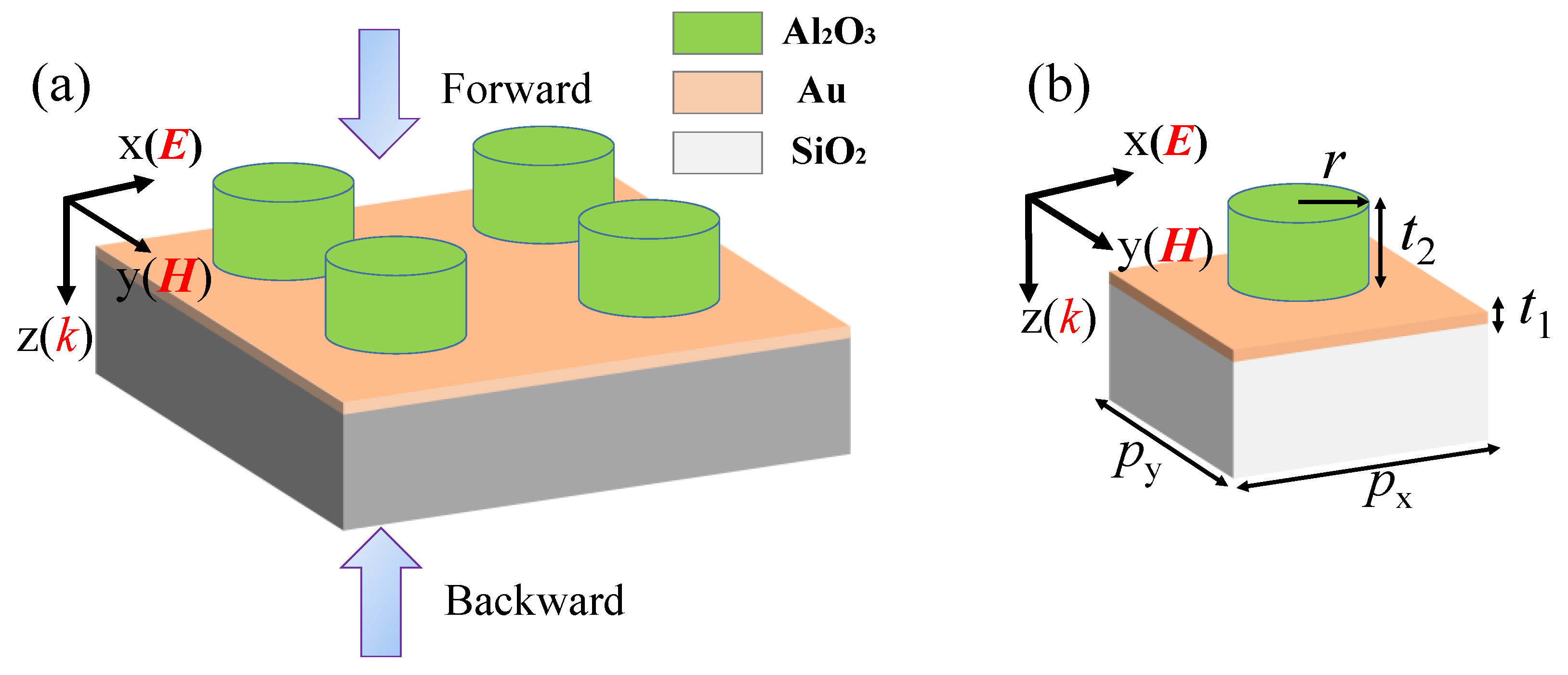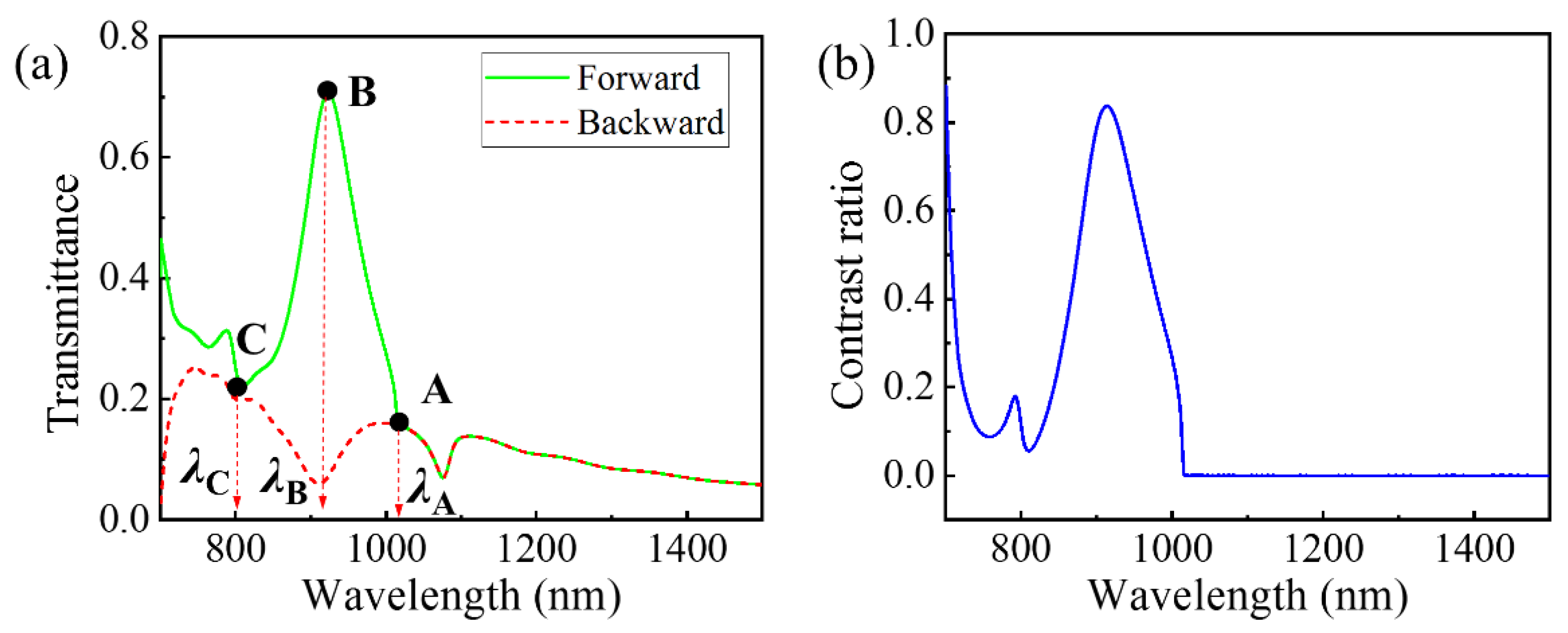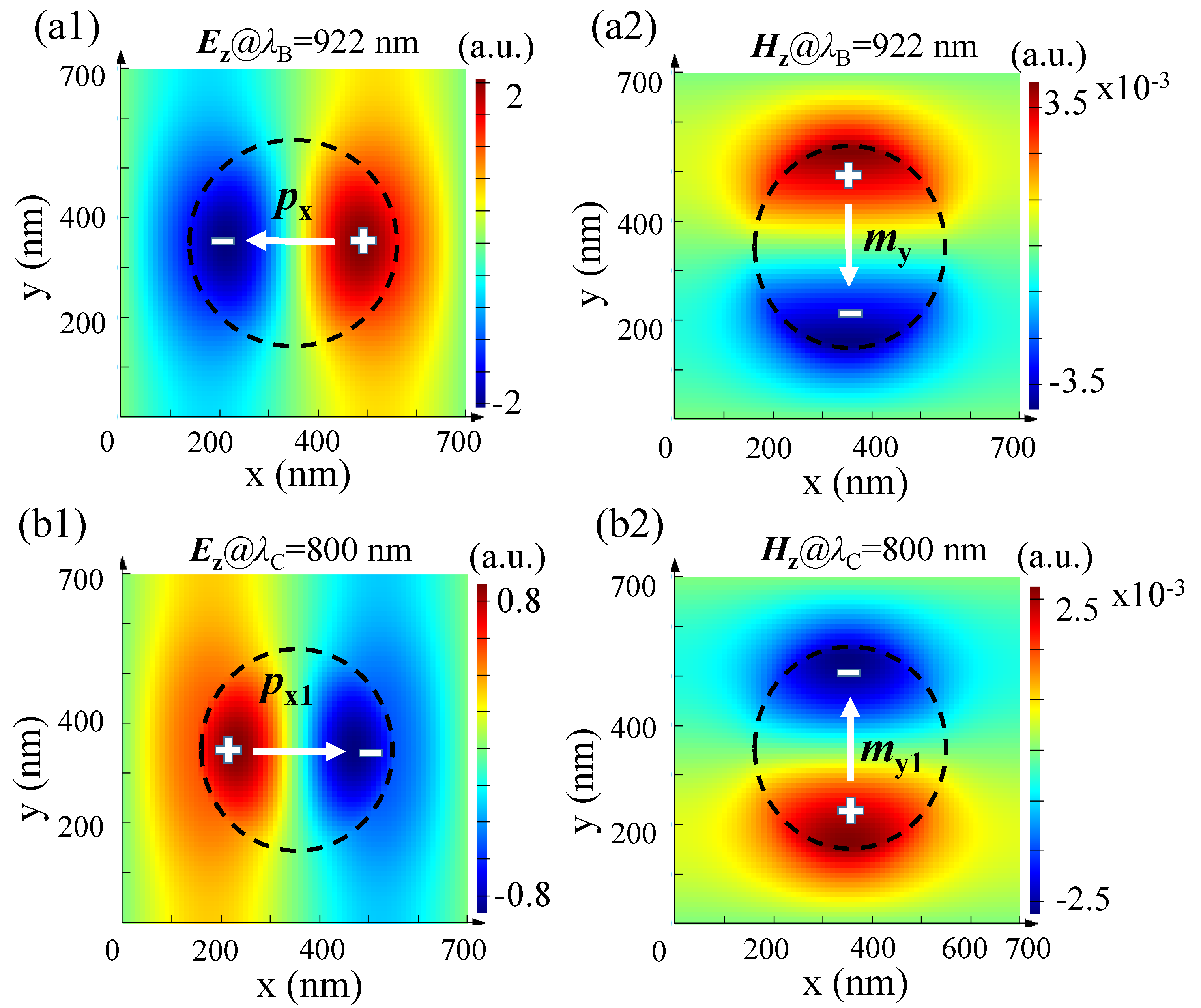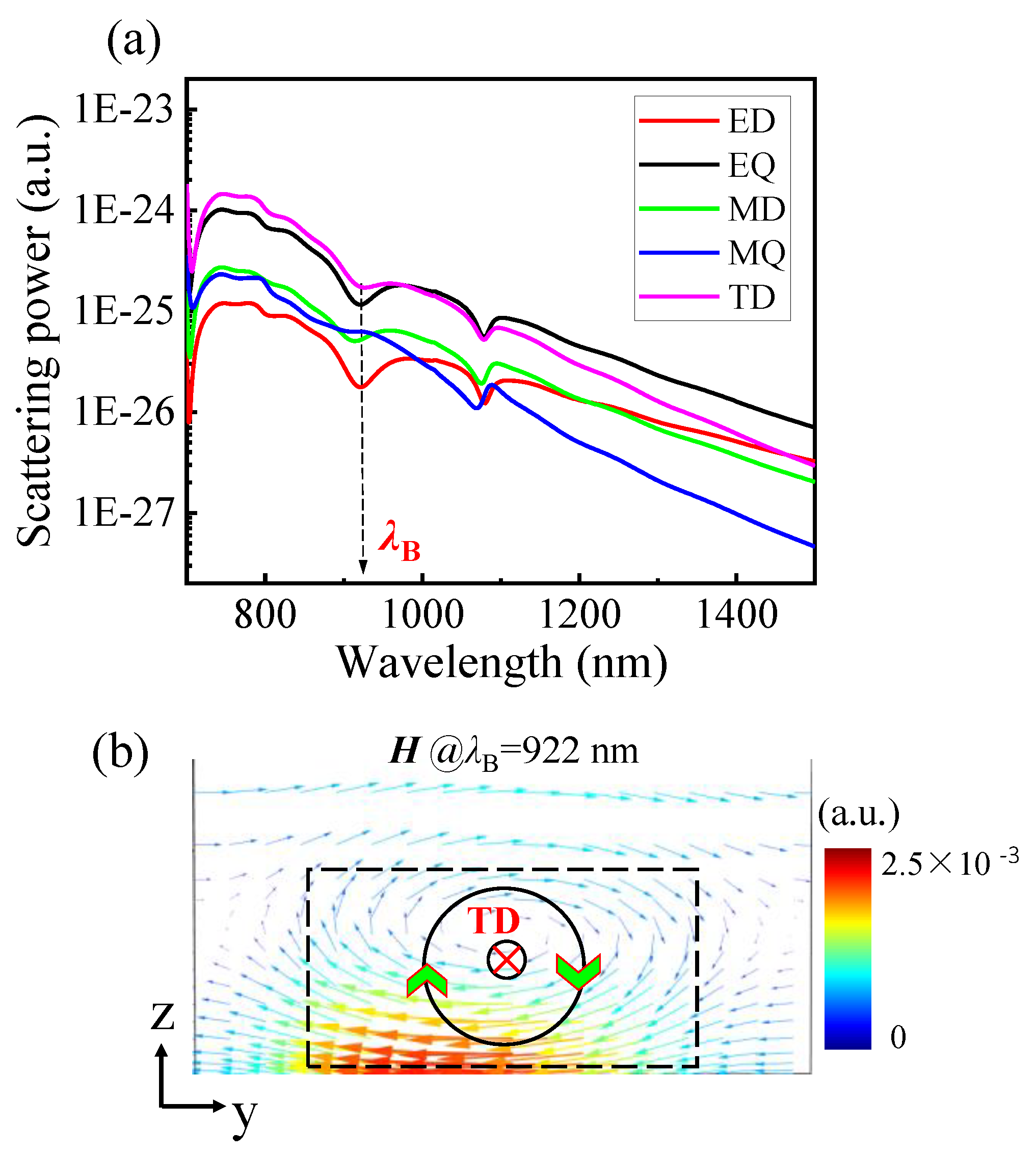High-Performance Asymmetric Optical Transmission Based on a Dielectric–Metal Metasurface
Abstract
:1. Introduction
2. Materials and Methods
3. Results and Discussion
3.1. High-Performance Asymmetric Transmission
3.2. Mechanism Analyses on Asymmetric Transmission
3.2.1. Role of Kerker Conditions in the Realization of the Forward Transmission Peak
3.2.2. Realization of the Low Backward Transmittance Dip
3.2.3. Effect of the Thickness of the Dielectric Disk and Au Layer on Asymmetric Transmission
4. Conclusions
Author Contributions
Funding
Institutional Review Board Statement
Informed Consent Statement
Data Availability Statement
Acknowledgments
Conflicts of Interest
References
- Jalas, D.; Petrov, A.; Eich, M.; Freude, W.; Fan, S.; Yu, Z.; Baets, R.; Popović, M.; Melloni, A.; Joannopoulos, J.D.; et al. What is-and what is not-an optical isolator. Nat. Photonics 2013, 7, 579–582. [Google Scholar] [CrossRef]
- Liu, N.; Zhao, J.; Du, L.; Niu, C.; Sun, C.; Kong, X.; Wang, Z.; Li, X. Giant nonreciprocal transmission in low-biased gyrotropic metasurfaces. Opt. Lett. 2020, 45, 5917. [Google Scholar] [CrossRef]
- Fan, L.; Wang, J.; Varghese, L.T.; Shen, H.; Niu, B.; Xuan, Y.; Weiner, A.M.; Qi, M. An all-silicon passive optical diode. Science 2012, 335, 447–450. [Google Scholar] [CrossRef] [PubMed] [Green Version]
- Zhao, N.-S.; Zhou, H.; Guo, Q.; Hu, W.; Yang, X.-B.; Lan, S.; Lin, X.-S. Design of highly efficient optical diodes based on the dynamics of nonlinear photonic crystal molecules. J. Opt. Soc. Am. B 2006, 23, 2434. [Google Scholar] [CrossRef]
- Sounas, D.L.; Alù, A. Non-reciprocal photonics based on time modulation. Nat. Photonics 2017, 11, 774–783. [Google Scholar] [CrossRef]
- Chin, J.Y.; Steinle, T.; Wehlus, T.; Dregely, D.; Weiss, T.; Belotelov, V.I.; Stritzker, B.; Giessen, H. Nonreciprocal plasmonics enables giant enhancement of thin-film Faraday rotation. Nat. Commun. 2013, 4, 1596–1599. [Google Scholar] [CrossRef] [PubMed] [Green Version]
- Zhu, Z.H.; Liu, K.; Xu, W.; Luo, Z.; Guo, C.C.; Yang, B.; Ma, T.; Yuan, X.D.; Ye, W.M. One-way transmission of linearly polarized light in plasmonic subwavelength metallic grating cascaded with dielectric grating. Opt. Lett. 2012, 37, 4008. [Google Scholar] [CrossRef]
- Cakmakyapan, S.; Caglayan, H.; Serebryannikov, A.E.; Ozbay, E. Experimental validation of strong directional selectivity in nonsymmetric metallic gratings with a subwavelength slit. Appl. Phys. Lett. 2011, 98, 7–10. [Google Scholar] [CrossRef]
- Bi, L.; Hu, J.; Jiang, P.; Kim, D.H.; Dionne, G.F.; Kimerling, L.C.; Ross, C.A. On-chip optical isolation in monolithically integrated non-reciprocal optical resonators. Nat. Photonics 2011, 5, 758–762. [Google Scholar] [CrossRef]
- Bi, Y.; Huang, L.; Li, X.; Wang, Y. Magnetically controllable metasurface and its application. Front. Optoelectron. 2021, 14, 154–169. [Google Scholar] [CrossRef]
- Lepri, S.; Casati, G. Asymmetric wave propagation in nonlinear systems. Phys. Rev. Lett. 2011, 106, 164101. [Google Scholar] [CrossRef] [PubMed] [Green Version]
- Ji, R.; Jin, C.; Song, K.; Wang, S.W.; Zhao, X. Design of multifunctional janus metasurface based on subwavelength grating. Nanomaterials 2021, 11, 1034. [Google Scholar] [CrossRef]
- Jing, L.; Lin, X.; Wang, Z.; Kaminer, I.; Hu, H.; Li, E.; Liu, Y.; Chen, M.; Zhang, B.; Chen, H. Polarization Shaping of Free-Electron Radiation by Gradient Bianisotropic Metasurfaces. Laser Photonics Rev. 2021, 15, 2000426. [Google Scholar] [CrossRef]
- Liu, S.; Dong, J.; Si, J.; Yang, W.; Yu, X.; Zhang, J.; Deng, X. Bidirectional electromagnetically induced transparency based on coupling of magnetic dipole modes in amorphous silicon metasurface. Nanomaterials 2021, 11, 1550. [Google Scholar] [CrossRef]
- Shields, J.; de Galarreta, C.R.; Bertolotti, J.; Wright, C.D. Enhanced performance and diffusion robustness of phase-change metasurfaces via a hybrid dielectric/plasmonic approach. Nanomaterials 2021, 11, 525. [Google Scholar] [CrossRef] [PubMed]
- Zhang, J.; Yu, X.; Dong, J.; Yang, W.; Liu, S.; Shen, C.; Duan, J.; Deng, X. A plasmonic infrared multiple-channel filter based on gold composite nanocavities metasurface. Nanomaterials 2021, 11, 1824. [Google Scholar] [CrossRef]
- Zhen, Z.; Qian, C.; Jia, Y.; Fan, Z.; Hao, R.; Cai, T.; Zheng, B.; Chen, H.; Li, E. Realizing transmitted metasurface cloak by a tandem neural network. Photonics Res. 2021, 9, B229. [Google Scholar] [CrossRef]
- Fedotov, V.A.; Mladyonov, P.L.; Prosvirnin, S.L.; Rogacheva, A.V.; Chen, Y.; Zheludev, N.I. Asymmetric propagation of electromagnetic waves through a planar chiral structure. Phys. Rev. Lett. 2006, 97, 167401. [Google Scholar] [CrossRef] [Green Version]
- Cakmak, A.O.; Colak, E.; Serebryannikov, A.E.; Ozbay, E. Unidirectional transmission in photonic-crystal gratings at beam-type illumination. Opt. Express 2010, 18, 22283. [Google Scholar] [CrossRef] [PubMed] [Green Version]
- Wang, Z.; Chong, Y.D.; Joannopoulos, J.D.; Soljačić, M. Reflection-free one-way edge modes in a gyromagnetic photonic crystal. Phys. Rev. Lett. 2008, 100, 772–775. [Google Scholar] [CrossRef]
- Ling, Y.; Huang, L.; Liu, T.; Sun, Y.; Luan, J.; Hong, W.; Yuan, G. Asymmetric electromagnetic wave transmitter based on one-way excitation of surface plasmon polaritons in gradient metasurface. Opt. Express 2017, 25, 13648–13658. [Google Scholar] [CrossRef] [PubMed]
- Li, S.; Huang, L.R.; Ling, Y.H.; Liu, W.B.; Ba, C.F.; Li, H.H. High-performance asymmetric optical transmission based on coupled complementary subwavelength gratings. Sci. Rep. 2019, 9, 17117. [Google Scholar] [CrossRef] [PubMed] [Green Version]
- Ba, C.; Huang, L.; Liu, W.; Li, S.; Ling, Y.; Li, H. Narrow-band and high-contrast asymmetric transmission based on metal-metal-metal asymmetric gratings. Opt. Express 2019, 27, 25107. [Google Scholar] [CrossRef] [PubMed]
- Khalichi, B.; Ghobadi, A.; Osgouei, A.K.; Ozbay, E. Diode like high-contrast asymmetric transmission of linearly polarized waves based on plasmon-tunneling effect coupling to electromagnetic radiation modes. J. Phys. D Appl. Phys. 2021, 54, 365102. [Google Scholar] [CrossRef]
- Li, Z.; Mutlu, M.; Ozbay, E. Highly asymmetric transmission of linearly polarized waves realized with a multilayered structure including chiral metamaterials. J. Phys. D Appl. Phys. 2014, 47, 075107. [Google Scholar] [CrossRef]
- Xiao, Z.; Liu, D.; Ma, X.; Wang, Z. Multi-band transmissions of chiral metamaterials based on Fabry-Perot like resonators. Opt. Express 2015, 23, 7053. [Google Scholar] [CrossRef]
- Li, X.; Feng, R.; Ding, W. Extremely high contrast asymmetric transmission with linear tunability in chiral metamaterials. J. Phys. D. Appl. Phys. 2018, 51, 145304. [Google Scholar] [CrossRef]
- Liu, W.; Wu, W.; Huang, L.; Ling, Y.; Ba, C.; Li, S.; Chun, Z.; Li, H. Dual-band asymmetric optical transmission of both linearly and circularly polarized waves using bilayer coupled complementary chiral metasurface. Opt. Express 2019, 27, 33399. [Google Scholar] [CrossRef]
- Dong, X.; Luo, X.; Zhou, Y.; Lu, Y.; Hu, F.; Xu, X.; Li, G. Switchable broadband and wide-angular terahertz asymmetric transmission based on a hybrid metal-VO 2 metasurface. Opt. Express 2020, 28, 30675. [Google Scholar] [CrossRef]
- Fu, T.; Liu, F.; An, Y.; Li, Q.; Xiao, G.; Sun, T.; Li, H. Narrow-band asymmetric transmission based on the dark mode of Fano resonance on symmetric trimeric metasurfaces. Opt. Express 2020, 28, 30141. [Google Scholar] [CrossRef]
- Kenanakis, G.; Xomalis, A.; Selimis, A.; Vamvakaki, M.; Farsari, M.; Kafesaki, M.; Soukoulis, C.M.; Economou, E.N. Three-dimensional infrared metamaterial with asymmetric transmission. ACS Photonics 2015, 2, 287–294. [Google Scholar] [CrossRef]
- Parappurath, N.; Alpeggiani, F.; Kuipers, L.; Verhagen, E. The Origin and Limit of Asymmetric Transmission in Chiral Resonators. ACS Photonics 2017, 4, 884–890. [Google Scholar] [CrossRef] [Green Version]
- Mutlu, M.; Akosman, A.E.; Serebryannikov, A.E.; Ozbay, E. Diodelike asymmetric transmission of linearly polarized waves using magnetoelectric coupling and electromagnetic wave tunneling. Phys. Rev. Lett. 2012, 108, 213905. [Google Scholar] [CrossRef]
- Kerker, M.; Wang, D.S.; Giles, C.L. Electromagnetic Scattering by Magnetic Spheres. J. Opt. Soc. Am. 1983, 73, 765–767. [Google Scholar] [CrossRef]
- Fan, K.; Shadrivov, I.V.; Miroshnichenko, A.E.; Padilla, W.J. Infrared all-dielectric Kerker metasurfaces. Opt. Express 2021, 29, 10518. [Google Scholar] [CrossRef] [PubMed]
- Liu, W.; Kivshar, Y.S. Generalized Kerker effects in nanophotonics and meta-optics. arXiv 2017, 26, 274–284. [Google Scholar] [CrossRef] [Green Version]
- Ding, J.; Huang, L.; Liu, W.; Ling, Y.; Wu, W.; Li, H. Mechanism and performance analyses of optical beam splitters using all-dielectric oligomer-based metasurfaces. Opt. Express 2020, 28, 32721–32737. [Google Scholar] [CrossRef]
- Wan, L.; Pan, D.; Feng, T.; Liu, W.; Potapov, A.A. A review of dielectric optical metasurfaces for spatial differentiation and edge detection. Front. Optoelectron. 2021, 14, 187–200. [Google Scholar] [CrossRef]
- Cheng, L.; Alaee, R.; Safari, A.; Karimi, M.; Zhang, L.; Boyd, R.W. Superscattering, Superabsorption, and Nonreciprocity in Nonlinear Antennas. ACS Photonics 2021, 8, 585–591. [Google Scholar] [CrossRef]
- Alaee, R.; Albooyeh, M.; Yazdi, M.; Komjani, N.; Simovski, C.; Lederer, F.; Rockstuhl, C. Magnetoelectric coupling in nonidentical plasmonic nanoparticles: Theory and applications. Phys. Rev. B Condens. Matter Mater. Phys. 2015, 91, 115119. [Google Scholar] [CrossRef] [Green Version]
- Tang, B.; Li, Z.; Liu, Z.; Callewaert, F.; Aydin, K. Broadband asymmetric light transmission through tapered metallic gratings at visible frequencies. Sci. Rep. 2016, 6, 39166a. [Google Scholar] [CrossRef]
- Ozer, A.; Kocer, H.; Kurt, H. Broadband and polarization-independent asymmetric transmission of visible light through a three-dimensional trapezoidal metallic metasurface. J. Opt. Soc. Am. B 2018, 35, 2111. [Google Scholar] [CrossRef]
- Fu, Y.H.; Kuznetsov, A.I.; Miroshnichenko, A.E.; Yu, Y.F.; Luk’yanchuk, B. Directional visible light scattering by silicon nanoparticles. Nat. Commun. 2013, 4, 1527. [Google Scholar] [CrossRef] [PubMed] [Green Version]
- Terekhov, P.D.; Babicheva, V.E.; Baryshnikova, K.V.; Shalin, A.S.; Karabchevsky, A.; Evlyukhin, A.B. Multipole analysis of dielectric metasurfaces composed of nonspherical nanoparticles and lattice invisibility effect. Phys. Rev. B 2019, 99. [Google Scholar] [CrossRef] [Green Version]
- Evlyukhin, A.B.; Chichkov, B.N. Multipole decompositions for directional light scattering. Phys. Rev. B 2019, 100, 125415. [Google Scholar] [CrossRef]
- Talebi, N.; Guo, S.; Van Aken, P.A. Theory and applications of toroidal moments in electrodynamics: Their emergence, characteristics, and technological relevance. Nanophotonics 2018, 7, 93–110. [Google Scholar] [CrossRef]
- Savinov, V.; Fedotov, V.A.; Zheludev, N.I. Toroidal dipolar excitation and macroscopic electromagnetic properties of metamaterials. Phys. Rev. B 2014, 89, 205112. [Google Scholar] [CrossRef]
- Huang, Y.W.; Chen, W.T.; Wu, P.C.; Fedotov, V.A.; Zheludev, N.I.; Tsai, D.P. Toroidal lasing spaser. Sci. Rep. 2013, 3, 1237. [Google Scholar] [CrossRef] [PubMed]
- Ahmadivand, A.; Gerislioglu, B.; Pala, N.; Member, S. Large-Modulation-Depth Polarization-Sensitive. IEEE Photonics Technol. Lett. 2017, 29, 1860–1863. [Google Scholar] [CrossRef]
- Ahmadivand, A.; Semmlinger, M.; Dong, L.; Gerislioglu, B.; Nordlander, P.; Halas, N.J. Toroidal Dipole-Enhanced Third Harmonic Generation of Deep Ultraviolet Light Using Plasmonic Meta-atoms. Nano Lett. 2019, 19, 605–611. [Google Scholar] [CrossRef]
- Koshelev, K.; Kivshar, Y. Dielectric Resonant Metaphotonics. ACS Photonics 2021, 8, 102–112. [Google Scholar] [CrossRef]
- Hu, J.; Lawrence, M.; Dionne, J.A. High Quality Factor Dielectric Metasurfaces for Ultraviolet Circular Dichroism Spectroscopy. ACS Photonics 2020, 7, 36–42. [Google Scholar] [CrossRef]




 .
.
 .
.

Publisher’s Note: MDPI stays neutral with regard to jurisdictional claims in published maps and institutional affiliations. |
© 2021 by the authors. Licensee MDPI, Basel, Switzerland. This article is an open access article distributed under the terms and conditions of the Creative Commons Attribution (CC BY) license (https://creativecommons.org/licenses/by/4.0/).
Share and Cite
Liu, W.; Huang, L.; Ding, J.; Xie, C.; Luo, Y.; Hong, W. High-Performance Asymmetric Optical Transmission Based on a Dielectric–Metal Metasurface. Nanomaterials 2021, 11, 2410. https://doi.org/10.3390/nano11092410
Liu W, Huang L, Ding J, Xie C, Luo Y, Hong W. High-Performance Asymmetric Optical Transmission Based on a Dielectric–Metal Metasurface. Nanomaterials. 2021; 11(9):2410. https://doi.org/10.3390/nano11092410
Chicago/Turabian StyleLiu, Wenbing, Lirong Huang, Jifei Ding, Chenkai Xie, Yi Luo, and Wei Hong. 2021. "High-Performance Asymmetric Optical Transmission Based on a Dielectric–Metal Metasurface" Nanomaterials 11, no. 9: 2410. https://doi.org/10.3390/nano11092410





